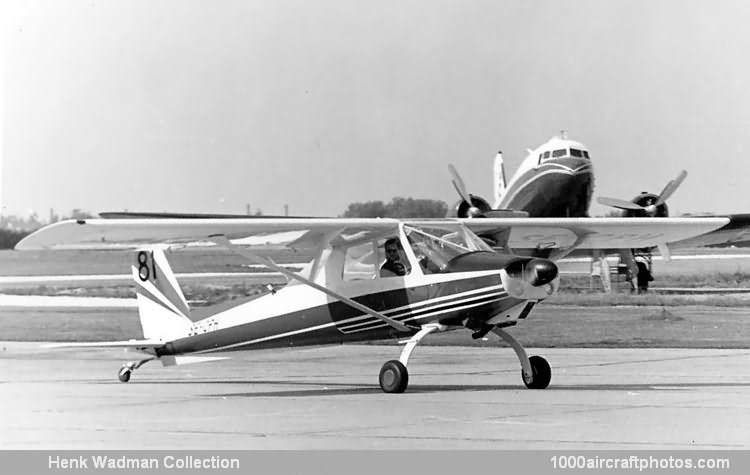First drawings for a four-seat monoplane were made in 1955 by Ernst Wohlberg, Rudolf Abelin and Ove Dahlen. Under Chief Engineer B. Thuneland it was developed in what became the Vipan (Peewit), that complied to a joint specification by the Royal Swedish Aero Club and the Swedish Defense Board. The specification was for an aircraft suitable for operation as a low-cost four-seat civil touring and utility aircraft and as a sturdy military AOP (airborne observation post) and casualty evacuation aircraft with short-field capability.
The Vipan was flown in two forms, the first version was designated MFI-10 and the single prototype was first flown on February 25, 1961, registered SE-CFI. The second version was known as the MFI-10B and two prototypes were produced to a Swedish Army contract under the designation Fpl 54 and s/n 54001, 54002. The first MFI-10B flew for the first time on June 27, 1962, registered as SE-CPH (c/n 02), the second became SE-CPI (c/n 03).
A unique feature of the Vipan was that its structure consisted almost entirely of a metal bonded honeycomb sandwich made up of two light alloy sheets with a symmetrical thin-foil honeycomb core. The cantilever main landing gear legs were made in one piece, of glass fiber, which was claimed to combine improved damping with light weight and resistance to corrosion.
Both MFI-10Bs were delivered to the Swedish Army in 1963, they received the new s/n 54381 and 54382, the latter was painted in a military livery. After a year evaluation they were returned to MFI in 1964 on March 23 and April 20 respectively and reappeared on the civil registry, again as SE-CPH and SE-CPI, both aircraft appeared at the Luftfahrtausstellung (Air Show) at Hannover, Germany, April 24 to May 3, 1964, where they were promoted by the Vereinigte Flugtechnische Werke (VFW), which had obtained a production license, although no production followed.
The sole MFI-10 SE-CFI went to the Arlanda Flygmuseum at Arlanda, Stockholm for preservation, while MFI-10B SE-CPH was sold to Spain on March 19, 1968, where it was registered as EC-CAN to ARCAMO at Salamanca. ARCAMO obtained a production license and promoted the aircraft, no orders were obtained and the aircraft was sold to the Real Aero Club de Granada. It crashed in Sotos near Cuenca, reportedly the wreckage is stored in a barn in Sotos. On September 18, 1972, MFI-10B SE-CPI was also stored at Arlanda near Stockholm for preservation, on August 26, 1980, it was transferred to the Flygvapenmuséet (AF museum).
However, in the early 1990s the German company Rhein-Flugzeugbau GmbH (RFB, formerly a subsidiary of VFW) saw a market for 150 MFI-10s as a basic flight trainer. RFB obtained the MFI-10B SE-CPI from the museum, fitted a 200 hp Lycoming IO-360-A engine and a three-bladed propeller, and displayed the aircraft as the MFI-10C at the 1993 Paris Air Show. The potential customer (reportedly Thailand) opted for another aircraft and on June 4, 1993, the aircraft returned to Sweden, and went to the Östergötlands Flyghistoriska Sällskap (Östergötland Aviation Historical Society), a year later, June 16, 1994 it returned to the Flygvapenmuséet."
Wings: Braced high-wing monoplane. Single bracing strut each side. Wing section NACA 25012. Aspect ratio 7.35. Constant chord of 4 ft 11 in (1.50 m). No dihedral. Incidence 3° 30'. No sweep at quarter-chord. All-metal structure of honeycomb sandwich stressed skin with only four ribs each side. Plastic wing tips. Frise-type ailerons and split flaps formed entire trailing edge of wing and were of honeycomb sandwich construction.
Fuselage: Forward portion of welded steel-tube construction. Rear portion of single-curvature monocoque of metal honeycomb sandwich.
Tail unit: Cantilever structure made of metal honeycomb sandwich. Variable incidence trimming tail plane. Trim-tab in rudder.
Landing gear: Non-retractable tail wheel type. Cantilever main legs made in one continuous piece from glass fiber. Goodyear wheels, tires and disc brakes. Main wheels size 6.00 x 6, pressure 28.5 lb/sq.in (2.0 kg/sq.cm). Tail wheel diameter 8 in (20 cm).
Power plant: MFI-10 had one 160 hp Lycoming O-320 four-cylinder horizontally-opposed air-cooled engine, driving a two-blade Hartzell constant-speed propeller. MFI-10B had a 180 hp Lycoming O-360-A1A four-cylinder horizontally-opposed air-cooled engine driving a Hartzell constant-speed propeller. Fuel in two integral tanks in wing roots, with total capacity of 52.83 gal (200 l). Refueling point above each tank. Oil capacity 1.98 gal (7.5 l).
Accommodation: Four persons in pairs in enclosed cabin, with dual controls. Two large doors on each side, without central pillars. Baggage compartment aft of rear seats. Cabin heating standard.
Electronics and equipment: Radio to customer's specification. Blind-flying instrumentation not standard.
